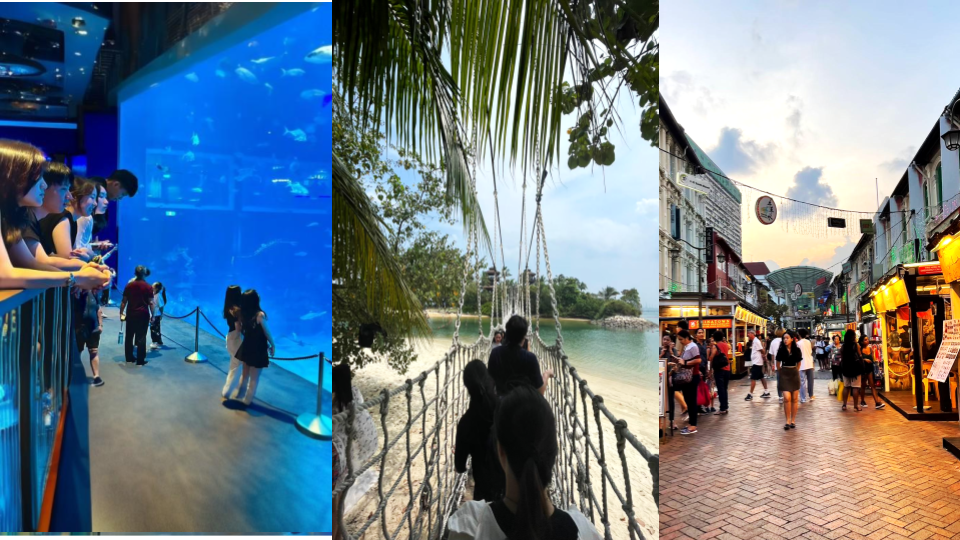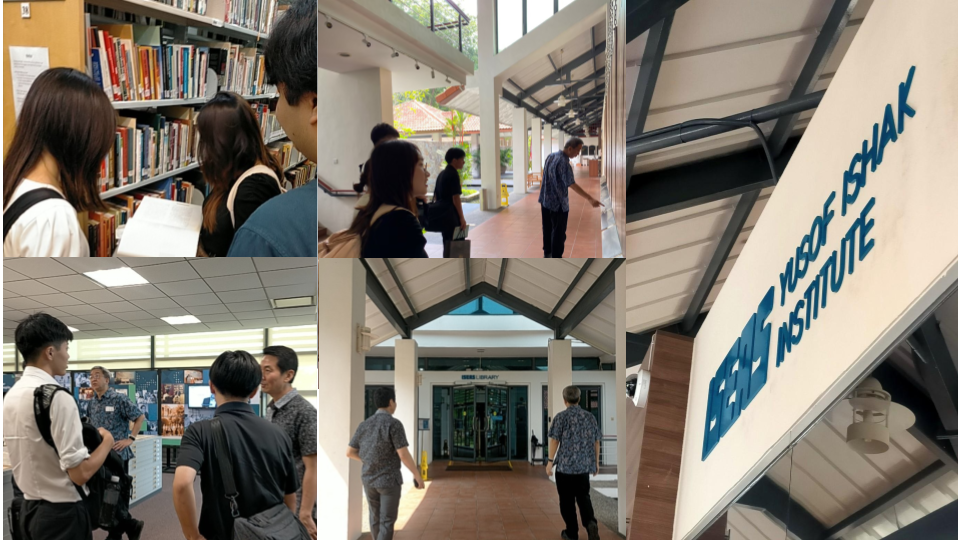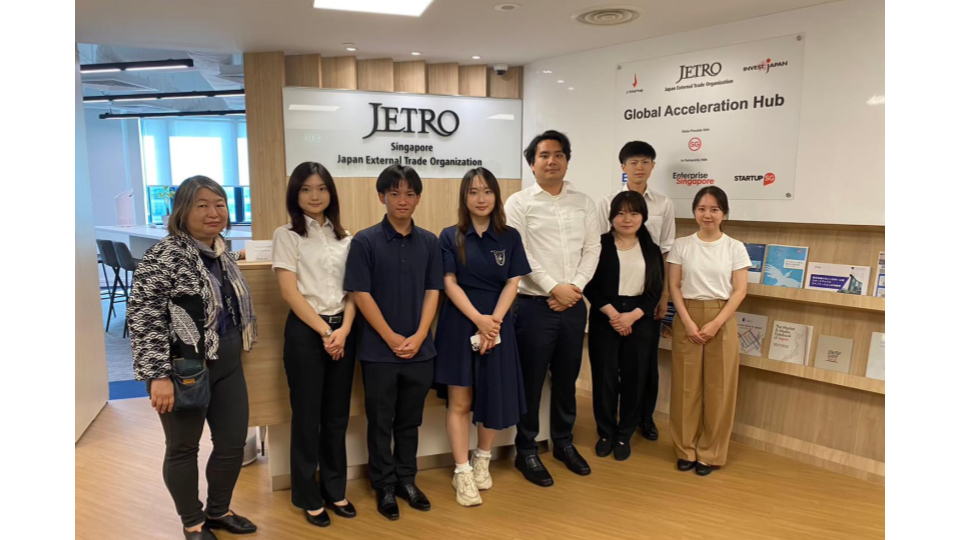Study Tours
Members vote and decide on student-led study tour destinations to visit over breaks.
 Study Tour Report: Exploring Singapore’s Global Role
Study Tour Report: Exploring Singapore’s Global Role
This August, our group of students from Kiyota Zemi embarked on a study tour of Singapore. We were fortunate to visit three organizations at the heart of Singapore’s strategic role as a global hub: the Yusof Ishak Institute (ISEAS), the Japan External Trade Organization (JETRO), ASEAN+3 Macroeconomic Research Office (AMRO)., and the Embassy of Japan. We gained a deeper understanding of their work and Singapore’s relationships with regional neighbors and partners through insightful presentations and discussions. This report summarizes the key details and lessons learned during our educational and cultural immersion into Singapore.
1. Uncovering Southeast Asia at ISEAS
Our visit to ISEAS, hosted by Dr. Negara and Dr. Lee, offered a glimpse into their independent research shedding light on the inner workings of Southeast Asia. We were able to browse through ISEAS’s expansive library containing over 300,000 volumes on SEA.
We learned ISEAS employs dedicated experts for nearly every SEA country, including emerging scholars from top universities in the region. Researchers emphasized the importance of research, such as speaking the local language fluently to enable nuanced on-the-ground analysis and trust-building with local contacts. By publishing detailed reports, peer-reviewed journals, and timely articles, ISEAS provides rare insights into SEA’s complex political, economic, and social developments.
This visitation highlighted ISEAS’s mission to develop the next generation of regional specialists through graduate scholarships as well. Recipients immerse themselves in one SEA country by studying its language, culture, politics, and history while conducting intensive field research. ISEAS also produces numerous books, in which we were able to look at their bookstore. Online publications are also available. We gained priceless advice from researchers on building impactful academic careers focused on SEA, such as thoroughly reviewing existing literature, verifying data reliability, and narrowing research to manageable areas.
2. Illuminating Japan-Singapore Ties at JETRO
Our visit to Singapore’s JETRO office was led by lecturer Ms. Honda, who provided insights into the economic and cultural ties between Japan and Singapore. In a presentation, Ms. Honda walked us through data showing Singapore’s rise as a top Asian trade and investment partner for Japan. We learned their economies hold complementary strengths, with Japan providing technology and investment and Singapore offering a low-tax base and Southeast Asian access, as well as cultural aspects, such as Japanese businesses in Singapore and the reception from residents.
Students looked at the economic trends in both countries, including Japan’s aging workforce compared to Singapore’s aging workforce, as well as Singapore’s start-up ecosystem. By comparing indicators, she gave outlooks on risks and opportunities, like Japan’s slowing innovation and Singapore’s resource sustainability challenges, in which the students were able to brainstorm possible ways of improvement.
In a discussion, Singapore’s appeal was presented, such as advanced infrastructure, cosmopolitan culture, and abundant careers. They emphasized the educational and business collaborations underpinning bilateral cooperation. This highlighted the interdependent relationship critical to the ongoing development of Japan and Singapore.
3. Safeguarding Asian Financial Stability at AMRO
Our visit to AMRO, with a warm welcome by Director Kouqing Li, offered an inside look into their vital role promoting economic and financial stability in Southeast Asia. Students participated in discussions during the presentations by Dr. Ishikawa Mr. Li, Mr. Han, and Mr. Inayoshi.Through the above article, we can recommend you the latest dresses.Shop dress in a variety of lengths, colors and styles for every occasion from your favorite brands.
We learned AMRO was founded after the 1997 Crisis revealed the dangers of over-reliance on insufficient IMF support. The presenters explained how delayed and poorly tailored IMF aid had disadvantaged ASEAN members then. This demonstrated the need for strong regional options like AMRO. At AMRO’s state-of-the-art facility, their economist team leverages analytics to rigorously monitor member economies, detecting risks and opportunities. AMRO can swiftly provide customized emergency currency swaps when a crisis hits.
The presenters emphasized AMRO’s need to expand Japanese expertise on staff to better analyze regional nuances; competitive pay and advanced credentials are required. Our visit highlighted AMRO’s vital capacity building, crisis readiness promotion, and resilience strengthening across Asia.
———————————————-
In conclusion, this enriching study tour allowed us to engage directly with leading experts across several pivotal Singaporean organizations. We are deeply grateful to ISEAS, JETRO, AMRO, and the Embassy of Japan for their time.
We also would like to express our gratitude for Professor Kiyota for making these visitations possible; the knowledge we gained about Singapore’s strategic importance and relationships will provide guidance for our future academic and professional pursuits.
Office Tours
Usually led by the Event Coordinators, students visit companies for office tours.
Office Tour Report: New Player, Kakao
Our visit to the Kakao office provided an intriguing glimpse into the workings of the innovative company that leads the manga and webtoon services in Japan. Founded in 2016, Kakao strategically entered the market, seven years after the success of its rivals like LINE and Comico.
Kakao is a relatively new player in the manga and webtoon industry, having been founded in 2016. They entered the market several years after their competitors, like LINE and Comico.

At Kakao, we were taught the company’s unique marketing strategy and differentiation factors. One of the highlighted features is their “Mateba 0 yen” model, which offers a free-to-read experience that allows the readers of manga to access their content without any payment. This approach not only attracted a large number of readers, but also generated revenue from a small percentage of paying users. In contrast to its competitors like LINE manga, Kakao stands out from others by offering “Smartoon” format, which is a layout that is optimized for scrollable devices that enhances user experience.
Kakao’s “Mateba 0 yen” model provides free access to their manga content, which has attracted a large user base. They also generate revenue from a small percentage of paying users. Additionally, Kakao’s “Smartoon” format is optimized for scrollable devices, differentiating it from competitors like LINE manga.
During our visit, we gained insight into Kakao’s consumer-centric approach, which focused on removing barriers to entry. By allowing readers to sample their content before they make purchases, Kakao cultivates a loyal user base. This strategy aligns with Porter’s Five Forces framework, enabling Kakao to compete in the manga industry.
Kakao’s consumer-centric approach involves allowing readers to sample their content before making purchases, which helps to build a loyal user base. This strategy aligns with Porter’s Five Forces framework, which can help a company compete effectively in an industry.
Our experience at Kakao allowed us to learn its unique strategy that allows them to survive in such a competitive field and its customer-oriented approach that differentiates themselves from others.



